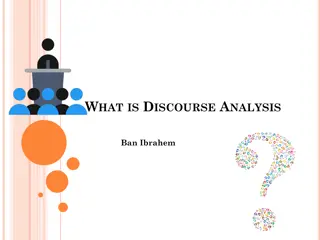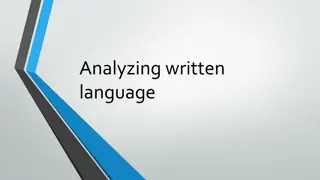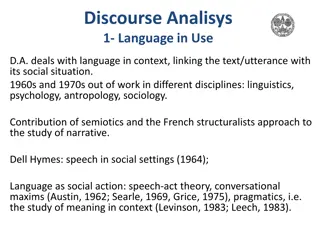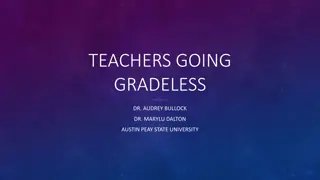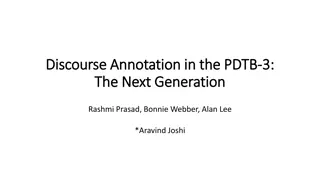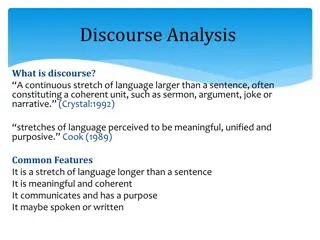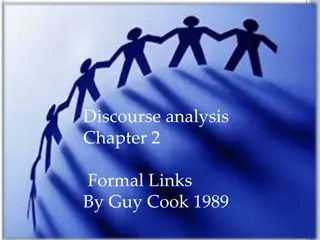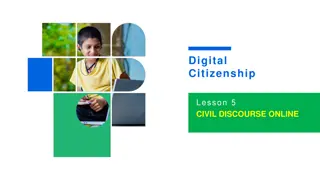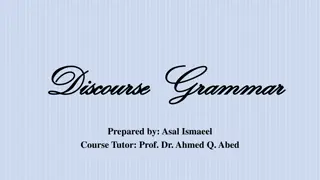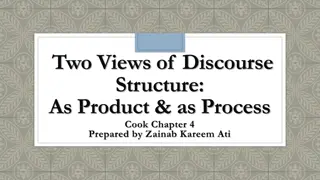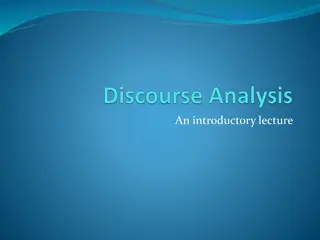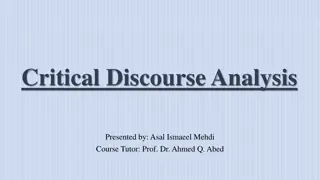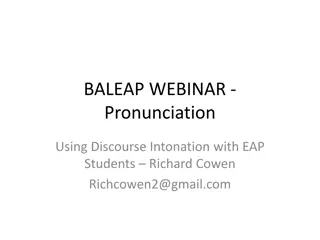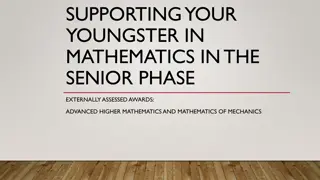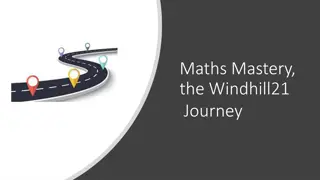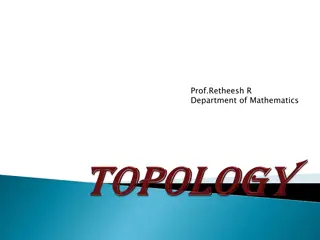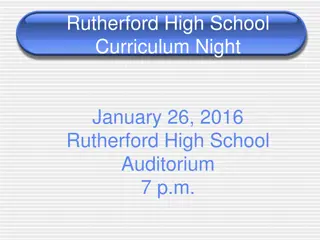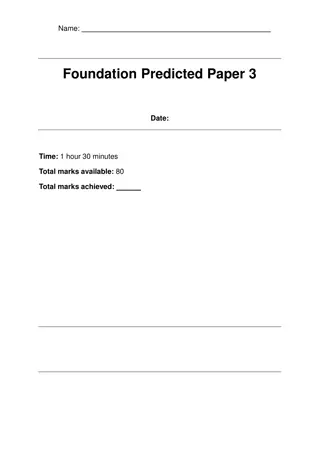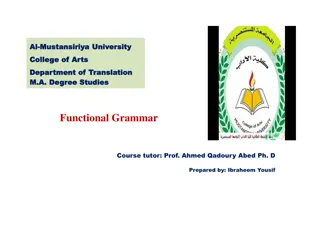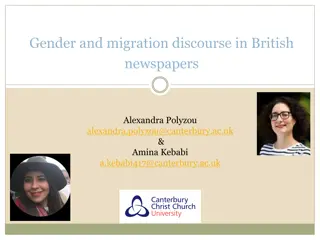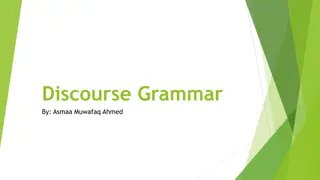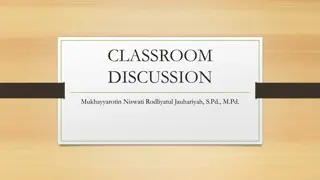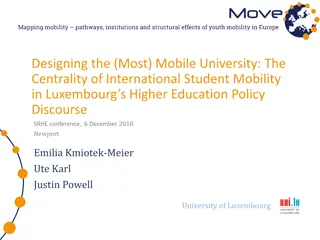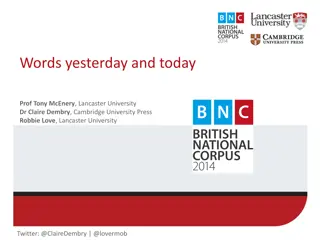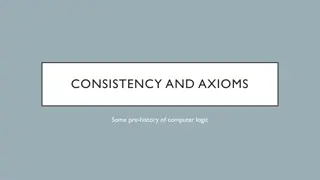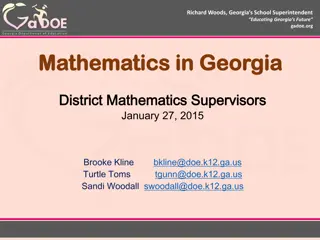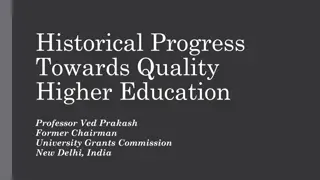Evolution of Mathematics Discourse in High Stakes Assessment
This study explores changes in school mathematics discourse over the past three decades in England through high stakes GCSE examinations. It analyzes the impact of these changes on classroom practices and student mathematical engagement, emphasizing the role of language in shaping mathematical experiences. The research focuses on the textual characteristics of examination discourse as indicators of mathematical activity.
Download Presentation

Please find below an Image/Link to download the presentation.
The content on the website is provided AS IS for your information and personal use only. It may not be sold, licensed, or shared on other websites without obtaining consent from the author. Download presentation by click this link. If you encounter any issues during the download, it is possible that the publisher has removed the file from their server.
E N D
Presentation Transcript
The evolution of mathematics discourse in high stakes assessment ALM July 2018 Candia Morgan UCL Institute of Education
Outline Introduction to the EDSM project, its aims, theoretical and methodological orientation The role of real world contextualisation of mathematics some findings and issues Discussion of implications for teachers and for curriculum and assessment development
Setting the scene Apparent changes in standards over time is a constant topic of debate and drives policy decisions. Clearly changes have happened in the mathematics curriculum, assessment and classroom practices but what have these changes meant for the mathematics that students are expected to engage in? How may change be studied? Focus on school mathematics but implications beyond for other formal educational settings
Project: The Evolution of the Discourse of School Mathematics project funded by ESRC 2010-2014 in collaboration with Anna Sfard and Sarah Tang aim: to characterise changes in school mathematics in England over the past 3 decades using high stakes GCSE examinations as a window onto school mathematics analysing textual characteristics of the discourse as indicators of mathematical activity
Theoretical assumptions High stakes examinations have a strong impact on classroom practice and thus serve as a window onto the mathematics that students experience and are expected to engage in We can investigate expectations of student experience by studying the discourse in which they are expected to engage The language we use shapes and is shaped by the way we experience the world There is no dualist distinction between doing/thinking mathematically and communicating mathematically Drawing on: Sfard s communicational theory social semiotics and systemic functional linguistics 5
Changes in the textual form of an examination question: do notsimply make the mathematics more or less difficult but change the ways in which a student may engage with the text and change the possible ways of mathematical thinking
Phase 1: Selection of data-base of exam papers 8 years from 1980 (GCE O Level) to 2011 (GCSE Higher Tier ) Phase 2: Development of analytical scheme developed iteratively in interaction with data, drawing on Sfard s mathematics discourse features and SFL Phase 3: Analysis of examination papers nVivo-supported coding; quantitative and qualitative comparisons across time Phases 4 & 5: Student testing & task-based interviews comparing success rates and strategies for parallel questions with different discursive features
Specialisation as a characteristic of mathematics communication/activity To what extent is specialised mathematical language used? lexical items used in accordance with mathematical definitions, considered at the level of: vocabulary sentence text unit extra-mathematical context depth of engagement with context
Real World Context - policy The extent of contextualisation in mathematics curriculum and assessment has been an on-going issue in policy debates and curriculum development in England. official policy discourse of utility critique of over-complicated assessment calls for return to basic skills of arithmetic and algebraic manipulation
Real World Context education community to increase motivation and engagement in mathematics to facilitate access to the specialised mathematics discourse by using familiar contexts as a bridge to provide students with insight into and skills in the application of mathematics in other disciplines, in employment, citizenship and everyday life to develop generic problem solving and modelling skills
Real World Context - assessment to increase accessibility of an assessment item by reducing abstraction or enabling students to relate to a familiar concrete experience to assess use of specific mathematical knowledge and skills and to relate these to their utility outside the classroom to assess ability to solve problems in which the relevant mathematical knowledge and skills are not specified by the assessment rubric
Problematising use of Real World context the activity of solving school mathematics tasks is not the same as the real world activity represented in the task formulaic word problems are often dealt with in instrumental ways, e.g. using linguistic cues rather than engaging with context students have to know exactly which contextual knowledge to use and which to ignore there are gender and social class differences in how students engage with contextualised tasks
We asked How has the use of extra-mathematical contexts varied over time in GCSE examinations? How may this affect student participation in mathematical discourse?
Analytic Scheme developed in interaction with the data, drawing on components of Sfard s communicative theory of mathematical discourse and Halliday s social semiotics coding supported by use of nVivo all questions coded as: specialised mathematics non-specialised mathematics mixed
Specialised mathematics 2011 only mathematical objects and processes throughout
Non-specialised mathematics 2004 some extra-mathematical objects or processes in every part of the question
Mixed 1980 presents an extra-mathematical context but some parts of the question are not related to this context
1982 Cockcroft Report triggered major reforms to make mathematics more accessible and an entitlement for all students. specialised non- mixed specialised 28% 64% 8% 1980 1988 National Curriculum Using and Applying Mathematics 20% of assessment 36% 56% 7% 1987 38% 61% 2% 1991 1995 QCA review calls for more algebra 40% 51% 9% 1995 1999 QCA review notes trivial or distracting context 49% 42% 8% 1999 2010 QCA AO2: Select and apply mathematical methods in a range of contexts 25- 35% 64% 28% 8% 2004 64% 36% 0% 2010 2011 Ofqual subject criteria: 20-30% for functional elements of mathematics 60% 37% 2% 2011
Going deeper Even where there is an element of extra-mathematical context in every part of a question, the relationship between the context and the expected mathematical activity varies. Depth of engagement with context required: ritual a contextualised question posed in a way so familiar within school mathematics that it may be considered an exercise mundane a superficial context, most of which can be ignored; the mathematics demanded is obvious deep significant engagement with the context is necessary in order to identify the mathematics demanded (based on Nyabanyaga, 2002)
Ritual context - a familiar exercise 16. In a sale the normal price of a book is reduced by 10%. 2011 The sale price of the book is 4.86 Calculate the normal price of the book.
Mundane context - mathematics demanded is obvious 2010
Deep context - engagement with context is essential 1987
More or less real? 0% 10% 20% 30% 40% 50% 60% 70% 80% 90% 100% 1980 1987 1991 Specialised Ritual Mundane Deep 1995 1999 2004 2010 2011 2017 0% 10% 20% 30% 40% 50% 60% 70% 80% 90% 100%
disconnected context frequent in recent data handling questions where the real life origin of the data is stated at the beginning but no reference is made to it in the tasks to be completed. 2010
irrelevant context frequent in Shape, Space and Measures, where a real life object is the object of study but no extra-mathematical knowledge or reasoning is required Emma visited a stately home. In one of the rooms there was a semi- circular carpet. The diameter of the carpet was 8 feet. Work out the area of the carpet. Give the units of your answer. 2010
Changes over time in use of non-mathematical contexts The proportion of questions involving only specialised mathematical discourse has returned to the 1980 level after a period when it was much reduced. The proportion of deep contextualisation has remained very low throughout. There has been variation in the depth of contexts. By 2010/11 the proportion of contexts categorised as ritual had risen. This is most evident in Handling Data questions. Use of Algebra in context has fallen to a negligible level.
How do variations in contextualisation affect students mathematical activity? Example 1: Comparison of student test responses to parallel questions with different relationships to context Example 2: Task-based interview with one student solving probability questions involving context in different ways
original 1995 contrived based on 2011
original question 1995 little specialised language no algebraic notation maximum and minimum values deep context Students are expected to engage with the context itself and to operate mathematically ( calculate ) on the objects of this context.
contrived question based on 2011 specialised mathematical language algebraic notation upper and lower bound mundane context The activity of mathematics involves operating on specialised mathematical objects Mathematics is construed as a specialised domain, applied to a real world context.
original 1995 fully correct answers all school A 23% school B 26% original version (less specialised) contrived version (more specialised) 25% 32% 40% 29% contrived 2011
Nearly half those answering the original (less specialised) version gave the upper and lower bounds of the population as their answer, making no attempt to work with the definition of population density.
Of those answering the contrived (more specialised) version, nearly half made the error of calculating the population density using only the given values.
Half of those answering the contrived version and a third of those answering the original version made an attempt to take account of the accuracy of population and/or area in order to calculate upper and lower bounds of population density. Of these, all those answering the contrived (more specialised) version used upper and lower bounds of both variables. But some of those answering the original question used upper and lower bound of area, together with the given approximate value for population.
conjectures based on this analysis specialised discourse in the question allows students to recognise necessary mathematical knowledge and techniques and to identify the relevant variables the use of everyday language to define population density seems to have been a major stumbling block the way information is structured may make a difference to students recognition of the role each piece of information plays in the solution
To get more detailed insight into student thinking we interviewed 12 16 year-old students in 3 schools. We asked them to solve 2 questions on each of 3 different topics: probability sequences angles The students talked as they wrote to make their thought processes clear to us.
2010 There are 3 orange sweets, 2 red sweets and 5 yellow sweets in a bag. Sarah takes a sweet at random. She eats the sweet. She then takes another sweet at random. Work out the probability that both sweets are the same colour.
1995 On average, Alice comes to tea on 2 days out of every 5. If Alice comes to tea, the probability that we have jam tarts is 0.7. If Alice does not come to tea, the probability that we have jam tarts is 0.4. In the space below, draw a tree diagram to illustrate this information. Write the appropriate probability on each branch. What is the probability that we will have jam tarts for tea tomorrow?
1995 2010 context: very familiar ritual vs. unfamiliar deep human presence: Sarah acting alone vs. Alice and we participating in a joint (possibly unfamiliar) social activity specialised modes: implicit vs. quantified probabilities and demand for tree diagram Information structure: Series of simple single clause sentences vs. subordinate conditional clauses. Logical structure: temporal narrative vs. description of general conditions 40
student responses sweets: 6 out of 12 correct probability errors due to incorrect choice of operation or calculation slips 11 out of 12 correct tree diagram (4 of whom omitted irrelevant branches) little reference to context after initial reading of question jam tarts: 4 out of 12 correct probability 3 out of 12 answer 7/25, considering only the case when Alice visits 9 out of 12 correct tree diagram frequent reference throughout to Alice, coming to tea, having jam tarts
Sweets Umm..right. ...yellow... And there s 3 out of 10 oranges 2 out of 10 and then 5 out of ten yellows So she takes a sweet at random, she then eats the treat sweet, and then takes another one ...ok same colour. I don t need to do3 but .... yellow red red... them two don t really need to be there. OK, orange would be 2 out of 9 because there's now 1 less because she's eaten it. Then this would be 1 out of 9 and this one would be 4 out of 9. So 3 over 10 times 2 over 9 plus 2 over 10 times 1 over 9, plus 5 over 10 times 4 over 9 equals they re all over 90 so you can do that... And that would be 6, that would be 2, that would be 20. And then that would equal 28 over 90. (1/1A)
Sweets reading the question Umm..right. ...yellow... And there s 3 out of 10 oranges 2 out of 10 and then 5 out of ten yellows So she takes a sweet at random, she then eats the treat sweet, and then takes another one ...ok same colour. I don t need to do3 but .... yellow red red... them two don t really need to be there. OK, orange would be 2 out of 9 because there's now 1 less because she's eaten it. Then this would be 1 out of 9 and this one would be 4 out of 9. So 3 over 10 times 2 over 9 plus 2 over 10 times 1 over 9, plus 5 over 10 times 4 over 9 equals they re all over 90 so you can do that... And that would be 6, that would be 2, that would be 20. And then that would equal 28 over 90. (1/1A) justifying solution method
Sweets Umm..right. ...yellow... And there s 3 out of 10 oranges 2 out of 10 and then 5 out of ten yellows So she takes a sweet at random, she then eats the treat sweet, and then takes another one ...ok same colour. I don t need to do3 but .... yellow red red... them two don t really need to be there. OK, orange would be 2 out of 9 because there's now 1 less because she's eaten it. Then this would be 1 out of 9 and this one would be 4 out of 9. So 3 over 10 times 2 over 9 plus 2 over 10 times 1 over 9, plus 5 over 10 times 4 over 9 equals they re all over 90 so you can do that... And that would be 6, that would be 2, that would be 20. And then that would equal 28 over 90. (1/1A)
Jam tarts ....Umm...So when they do the probability that they have jam tarts is that they do have and then they do not do not They do when she does come for tea. I think these are both the same; I need to cross one out. OK. She does this is comes to tea and this one is jam tarts. OK, so the probability they do is 0.7 which actually should be 7 out of 10 I think? Change that to 7 out of 10. And then this would mean that was 3 out of 10 and when she does not come to tea it's 4 out of 10. And then that one would be 6 out of 10 I think. And then, what is the probability and that needs to be .(?)..as well.What is the probability that we will have jam tarts for tea tomorrow? Um so if she comes OK, she will come to tea 2 out of 5 OK I think it's them two, so that s 2 out of 5 times 3 out of 10 equals 14 out of 50, which is also 7 out of 25. There. (1/1A)
Jam tarts ....Umm...So when they do the probability that they have jam tarts is that they do have and then they do not do not They do when she does come for tea. I think these are both the same; I need to cross one out. OK. She does this is comes to tea and this one is jam tarts. OK, so the probability they do is 0.7 which actually should be 7 out of 10 I think? Change that to 7 out of 10. And then this would mean that was 3 out of 10 and when she does not come to tea it's 4 out of 10. And then that one would be 6 out of 10 I think. And then, what is the probability and that needs to be .(?)..as well.What is the probability that we will have jam tarts for tea tomorrow? Um so if she comes OK, she will come to tea 2 out of 5 OK I think it's them two, so that s 2 out of 5 times 3 out of 10 equals 14 out of 50, which is also 7 out of 25. There. (1/1A)
Jam tarts ....Umm...So when they do the probability that they have jam tarts is that they do have and then they do not do not They do when she does come for tea. I think these are both the same; I need to cross one out. OK. She does this is comes to tea and this one is jam tarts. OK, so the probability they do is 0.7 which actually should be 7 out of 10 I think? Change that to 7 out of 10. And then this would mean that was 3 out of 10 and when she does not come to tea it's 4 out of 10. And then that one would be 6 out of 10 I think. And then, what is the probability and that needs to be .(?)..as well.What is the probability that we will have jam tarts for tea tomorrow? Um so if she comes OK, she will come to tea 2 out of 5 OK I think it's them two, so that s 2 out of 5 times 3 out of 10 equals 14 out of 50, which is also 7 out of 25. There. (1/1A)
Conjectures based on this analysis references to context play several roles during problem solving these roles vary with the depth of the contextualisation a task with ritual contextualisation is more likely to be solved fluently complexity of task information structure affects problem solving processes
Implications and discussion points What are the objectives of contextualisation? How do we want students to engage with mathematics (in context)? What roles do tasks with ritual, mundane or deep contextualisation have in teaching, learning and assessment? Is it possible to resolve tensions between access and authenticity?
Morgan, C., & Sfard, A. (2016). Investigating changes in high- stakes examinations: A discursive approach. Research in Mathematics Education, 18(2), 92-119. doi:10.1080/14794802.2016.1176596 Morgan, C., & Tang, S. (2016). To what extent are students expected to participate in specialised mathematical discourse? Change over time in school mathematics in England. Research in Mathematics Education, 18(2), 142-164. doi:10.1080/14794802.2016.1174145 Smith, C., & Morgan, C. (2016). Curricular orientations to real- world contexts in mathematics. The Curriculum Journal, 27. doi:10.1080/09585176.2016.1139498 50


